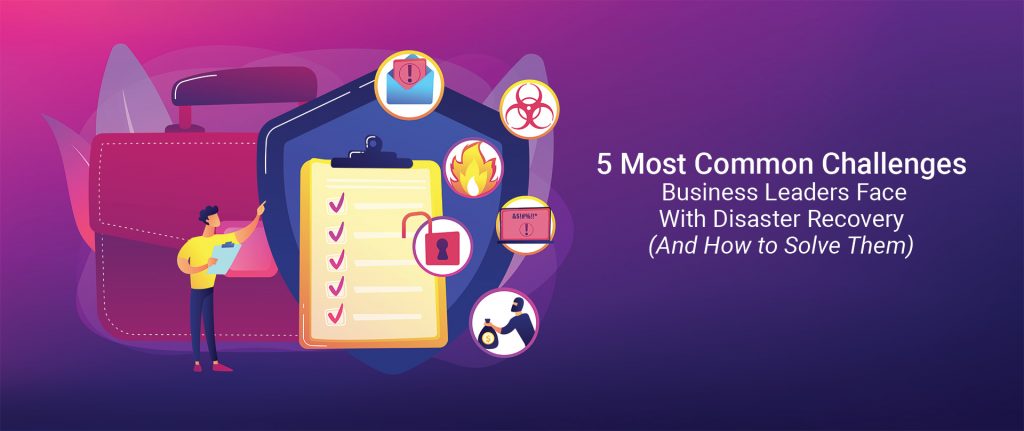You’ve, no doubt, encountered a disaster recovery situation, whether it’s a full-scale service disruption or a single application outage. No matter the scale, you’ve likely come out on the other end of your first experience, realising that your response was slower than expected and the outcome didn’t go exactly as planned.
Even with the leaps and bounds in business continuity technologies over the past decade, downtime and disruptions remain a harsh reality. In fact, a recent outage impact study shows that an alarming 96% of organizations faced at least one downtime incident between 2019 and 2022. This means that both fledgling enterprises and corporate giants are at risk.
Add to that the ever-evolving threat of ransomware and the high stakes of disaster recovery in protecting your business, data, and reputation, and you have a pressure cooker ready to blow. Unless you have a robust and up-to-date disaster recovery plan at the center of your business strategy. A plan that can be implemented smoothly when disaster strikes.
What are Today’s Top Disaster Recovery Challenges
For business leaders, this is often easier said than done. You know that disaster recovery planning is essential for your business operations, but you often feel overwhelmed with the challenges of getting it right.
There are resource limitations, data complexity, ever-changing cyber threats to keep up with, and expensive recovery technology that you have to consider when devising your disaster recovery plan. Plus, you have to balance compliance and cost in the process.
Let’s look at the 5 most common challenges and give you some insights on how your business can overcome them to ensure you are adequately prepared for unexpected events.
1. Lack of Resources
One of the biggest challenges business leaders faces is a lack of resources, including funding, personnel, and technology. Disaster recovery planning requires a significant investment of time and money, and many organizations struggle to allocate the necessary resources to ensure they are adequately prepared.
Solution: To overcome this challenge, your cloud service provider should match you with a scalable solution that can grow in tandem with your data, infrastructure, and needs and won’t cost you an arm and a leg. Additionally, you need to make sure that their technology or offerings align with your current setup. For instance, are you primarily using VMWare, cloud, on-premise, or a combination of these. Can they back up and recover all of your data and systems, or will they attempt to transition you to a different technology stack? It’s crucial to find a provider who understands and caters to your specific requirements.
2. The complexity of data
Disaster recovery planning can be complex, especially for organizations with multiple locations, complex IT infrastructures, and a wide range of applications and systems. Still, business leaders must navigate these complexities to ensure their disaster recovery plans are comprehensive and effective.
Solution: Disaster recovery experts can help you understand the complexity of your data and develop a plan for your business that is tailored to your specific needs. This may involve conducting a risk assessment to identify potential threats and vulnerabilities, developing a disaster recovery strategy that includes backup and recovery procedures, and testing the plan to ensure that it is effective.
3. Changing threat landscape
Business leaders must stay current on the evolving cyber threat landscape, including the latest cyber threats and vulnerabilities, to ensure their disaster recovery plans can withstand, say, a ransomware attack. This requires ongoing monitoring and analysis of potential threats and vulnerabilities and regular updates to disaster recovery plans to address new risks. It can be time-consuming and is often not a business leader’s wheelhouse.
Solution: Consider working with disaster recovery experts. They are up to date on the latest cyber threats and developments in disaster recovery and can provide guidance and advice to make sure you have a robust disaster recovery strategy.
4. Testing and maintenance
Disaster recovery plans must be regularly tested and maintained to verify the execution of the failover and failback processes meet or exceed expectations and sufficiently minimize disruption to the business. However, many organizations struggle to find the time and resources to conduct regular testing and maintenance, leaving them vulnerable to unexpected events.
Solution: There’s no getting around it – you have to regularly test your disaster recovery plan to make sure it’s effective and able to meet your RPOs and RTOs. This may involve conducting tabletop exercises, simulating disaster scenarios, and testing failover procedures. A cloud service provider’s disaster recovery solution should include regular testing and maintenance schedules.
5. High costs of disaster recovery technology
Investing in disaster recovery technology can be expensive, posing a financial challenge for many businesses.
Solution: There are several strategies that you can employ to overcome this challenge. By prioritizing critical systems, considering cloud-based solutions, leveraging virtualization, outsourcing, and conducting a cost-benefit analysis, you’ll be able to implement an effective disaster recovery plan without breaking the bank.
What Should Business Leaders Look for in a Cloud Service Provider to Overcome These Challenges?
The most clear-cut, overarching solution to overcome these challenges is to use a cloud service provider that has the expertise, infrastructure and resources to offer the following options as part of their disaster recovery services and solutions:
- A tiered approach: A cloud service provider offering a broad range of disaster recovery solutions, including cloud backup, data mirroring, network recovery, and as-a-service solutions, lets customers choose the product or combination of products that best meet their disaster recovery needs.
- An effective disaster recovery plan: An effective disaster recovery plan should include complete data visibility for insights into growth, usage, and ransomware protection, as well as compliance and governance.
- Orchestrated recovery: Orchestrated recovery solutions help businesses recover from disasters with minimal impact and recover single applications or entire sites from any location. This includes automated disaster recovery plan documentation, testing and verification, and zero-impact disaster recovery tests to ensure that required RTOs and RPOs can be met.
- Hybrid cloud services: Hybrid cloud services simplify backup and disaster recovery for customers of all sizes as they transition from private to public cloud.
Final Thoughts
Disaster recovery plays a pivotal role in safeguarding any business, though it does come with its own set of hurdles. It necessitates the proper allocation of resources, an understanding of its intricate nature, regular testing of your disaster recovery plan, and keeping abreast of the latest cyber threats and vulnerabilities to guarantee your business can bounce back swiftly and efficiently from potential disruptions or outages.
To ease your burden while ensuring your business is well-armed for any unforeseen disaster, consider teaming up with a cloud service provider. They not only shield your business from data losses – regardless of what triggers them – but also guarantee that your operations remain uninterrupted during disruptions or outages.
To find out how Stage2Data can help you prepare for and recover from disasters through our range of disaster recovery services and solutions, get in touch.






